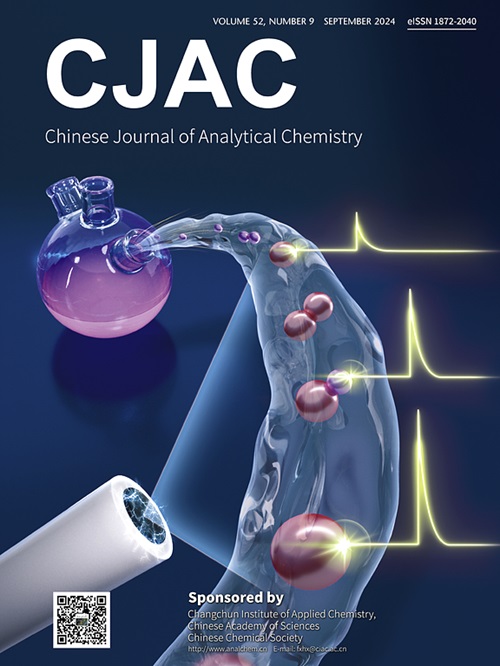Synthesis and characterization of folic acid-modified polyethylene glycol-coated holmium nanoparticles as targeted magnetic resonance imaging agent candidate
IF 1.2
4区 化学
Q4 CHEMISTRY, ANALYTICAL
引用次数: 0
Abstract
This study demonstrates a new candidate for targeted magnetic resonance imaging (MRI) contrast agent (CA) based on holmium nanoparticles. MRI is one of the most powerful diagnostic tools in cancer diagnosis which enables anatomical images of soft tissues with a resolution much higher than other imaging techniques. Holmium has been known for its high magnetic moment which can improve MRI signals as T2-MRI CA. This research focuses on modifying folic acid (FA) on the surface of polyethyelene glycol coated- holmium nanoparticles to deliver holmium nanoparticles selectively to the cancer-overexpressed FA receptors, such as cervical cancer. Their preparation and characterization with several analytical instruments such as transmission electron microscopy to observe their shape and size, thermal gravimetric analysis, ultraviolet and infrared spectroscopies to investigate the FA and polyethylene glycol molecules on nanoparticles are also included. From the results, morphology images show a narrow size distribution below 20 nm after the functionalization of polyethyelene glycol-coated holmium nanoparticles with and without FA modification. Based on ultraviolet and infrared spectrum analysis, the presences of FA and polyethylene glycol molecules on nanoparticles were also identified. The typical peaks of FA at around 280 and 360 nm were found on FA-modified nanoparticles spectras. In addition, infrared spectroscopy results at around 2800 cm–1 originated from polyethylene glycol molecules on nanoparticles was also observed. Furthermore, based on a preliminary cytotoxicity study, there are no significant differences between polyethylene glycol-coated nanoparticles modified with and without FA in terms of toxicity. Based on these results, FA-modified holmium nanoparticles showed promising preliminary results to be utilized as targeted MRI CA for diagnostic purposes.

叶酸修饰聚乙二醇包覆钬纳米粒子的合成与表征
本研究提出了一种基于钬纳米粒子的靶向磁共振成像造影剂(CA)。MRI是癌症诊断中最强大的诊断工具之一,它能够以比其他成像技术更高的分辨率获得软组织解剖图像。钬具有高磁矩特性,可作为T2-MRI CA改善MRI信号。本研究的重点是修饰聚乙二醇包被钬纳米粒子表面的叶酸(FA),以选择性地将钬纳米粒子递送到癌症过度表达的FA受体,如宫颈癌。本文还介绍了纳米粒子的制备和表征方法,包括用透射电子显微镜观察纳米粒子的形状和大小、热重分析、紫外和红外光谱研究纳米粒子上的FA和聚乙二醇分子。结果表明,经FA修饰和不经FA修饰的聚乙二醇包覆的钬纳米粒子在20 nm以下具有狭窄的尺寸分布。通过紫外和红外光谱分析,确定了纳米颗粒上存在FA和聚乙二醇分子。在FA修饰的纳米粒子光谱中,FA的典型峰位于280 nm和360 nm左右。此外,还观察到纳米颗粒上聚乙二醇分子在2800 cm-1左右的红外光谱结果。此外,根据一项初步的细胞毒性研究,在毒性方面,经FA修饰和未经FA修饰的聚乙二醇包被纳米颗粒没有显著差异。基于这些结果,fa修饰的钬纳米颗粒显示出有希望的初步结果,用于诊断目的的靶向MRI CA。
本文章由计算机程序翻译,如有差异,请以英文原文为准。
求助全文
约1分钟内获得全文
求助全文
来源期刊
CiteScore
3.60
自引率
25.00%
发文量
17223
审稿时长
35 days
期刊介绍:
Chinese Journal of Analytical Chemistry(CJAC) is an academic journal of analytical chemistry established in 1972 and sponsored by the Chinese Chemical Society and Changchun Institute of Applied Chemistry, Chinese Academy of Sciences. Its objectives are to report the original scientific research achievements and review the recent development of analytical chemistry in all areas. The journal sets up 5 columns including Research Papers, Research Notes, Experimental Technique and Instrument, Review and Progress and Summary Accounts. The journal published monthly in Chinese language. A detailed abstract, keywords and the titles of figures and tables are provided in English, except column of Summary Accounts. Prof. Wang Erkang, an outstanding analytical chemist, academician of Chinese Academy of Sciences & Third World Academy of Sciences, holds the post of the Editor-in-chief.

 求助内容:
求助内容: 应助结果提醒方式:
应助结果提醒方式:


